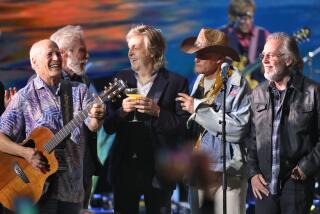Twin Bill Turns to Double Rarity: a Masters’ Duet
- Share via
COSTA MESA — When vocalist Joe Williams came out to join saxophonist Joe Henderson at the end of their double-bill concert Friday at the Orange County Performing Arts Center, the two did something they had done only once before. They made music together.
The only other time was at President Clinton’s inauguration in 1992. Here, the occasion may have been less historic, but the performance was every bit as noteworthy.
Beginning tentatively, like new dance partners measuring each other’s moves, the two took up Thelonious Monk’s “Monk’s Blues,” seeking common ground by experimenting with harmonies and call-and-response patterns. Before the first chorus was out, they’d found perfectly wonderful ways to blend their sounds.
Williams, his voice scatting in the guise of both trumpet and trombone, used slide and wah-wah effects when he sang the lead. Henderson tagged these efforts with his trademark riffs and descending flurries of notes.
So perfect was their combined reading that Henderson’s supporting musicians dropped out of the last chorus to let the two men harmoniously end the tune.
It was a remarkable close to a remarkable concert, one in which two leaders of their chosen crafts turned the spacious confines of Segerstrom Hall into a place that felt more like an intimate jazz club, in which the musicians feed off of audience response. While Henderson took a few numbers to warm to the space during his closing set, Williams showed his usual flair and command from the start.
There was much that was familiar in the singer’s opening set, with trademark numbers like “Please Don’t Talk About Me When I’m Gone,” “Who She Do” and “Well All Right” leading the pace. Williams also presented numbers from a recent recording of spirituals, and their reverent tones contrasted sharply from Williams’ often ribald performance of the blues.
While the 77-year-old singer still brings his trademark enthusiasm to the stage, his voice has suffered in the last few years. The rich, woody baritone sounds have given way to a thinner tone that more resembles sheet metal in its glossy character. His pitch has become a hit-and-miss affair, something he works around with spoken lines delivered with a thespian’s flare and timing.
But Williams can still give a convincing presentation. He showed bravado opening his program unaccompanied on a deliberately paced version of the devotional number “Go Down Moses.” His treatment of the ballad “Don’t You Know I Care” was the sort that raises goose bumps with its shared intimacy. And he showed he can still swing hard on “Satin Doll” and his medley of “Everyday I Have the Blues” and “All Blues.”
Henderson, on the other hand, seemed right on top of his game, though it took him a tune or two to get there. Working with a Brazilian-minded rhythm section to play tunes from his recent tribute album to Antonio Carlos Jobim, Henderson spoke softly on his instrument, seemingly exploring its parameters, before breaking loose on his own 30-year-old composition “Inner Urge.”
Henderson’s first efforts were light, breathy affairs that offered strings of quietly stated ascending lines. But he kicked loose on “Urge,” employing a wide array of rhythmic riffs and trademark Hendersonisms--cries, caterwauls, up-register warbles--while creating an involved, engaging story line.
His rendition of Billy Strayhorn’s “Take the ‘A’ Train,” backed only by drummer Paulo Braga, was a model of exposition and dynamic development. Likewise, his solo turn on Strayhorn’s “Lush Life” hinted subtly at the theme while refashioning it in Henderson’s image.
His band of Brazilians--Braga, pianist Helio Alves and bassist Nila Matta--brought a strong rhythmic feel to even the jazz tunes, with Alves creating especially dense, percussive displays. As a soloist, Alves tended to break his flow with chordal accents, occasionally giving his improvisations a herky-jerky pace.
But the evening’s highlight was seeing these two masters working together for only the second time. And the success of that joint effort underlined the spontaneity and coming-together spirit of jazz at its finest.
More to Read
The biggest entertainment stories
Get our big stories about Hollywood, film, television, music, arts, culture and more right in your inbox as soon as they publish.
You may occasionally receive promotional content from the Los Angeles Times.










